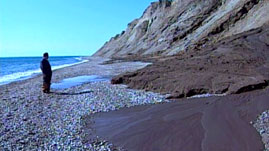Teachers' Domain - Digital Media for the Classroom and Professional Development
User: Preview

Source: International Institute for Sustainable Development
This video adapted from the International Institute for Sustainable Development discusses the changes happening to permafrost in the Arctic landscape. Alaska Native peoples and Western scientists discuss both the causes of melting and its impact on the ecosystem. The video shows the consequences of erosion, including mudslides and inland lakes being drained of water. An Inuit expresses his uncertainty about the ultimate effect this will have on his community and culture.
Much of Alaska and the terrestrial Arctic are covered by a layer of frozen soil called permafrost. At the highest latitudes, a zone of permanent permafrost exists. Further south, in a zone of semipermanent permafrost, the topmost layer—called the active layer—thaws to a depth of a few centimeters each summer and re-freezes in winter. Still farther south is the sporadic permafrost zone, in which the active layer goes several meters deep and where the surface freezes less often.
Permafrost consists of large cavities of pure ice and ground ice, or ice that forms in pore spaces and bonds to sediments in the soil. Healthy Arctic permafrost can support a thriving ecosystem in spite of the harsh, extreme environment. Soil microbes live in both the active and frozen ground layers. Shallow-rooted plants, such as sedge, lichen, and willow, also grow well in the rocky soil. And mammals, birds, and insects find food and habitat in the ponds and bogs that form each summer, when meltwater unable to drain through the underlying permanent ice layer collects at the surface.
All permafrost zones have experienced thawing and an overall decrease in permafrost in the past few decades as a result of increasing surface temperatures. When the upper layer melts, more water is released into the tundra, making the surface layer less stable and more prone to cave-ins and landslides. Surface layer disruptions expose more and more permafrost to the heat and wind, which only accelerates thawing.
Climate models predict that over half of the area covered by permafrost now could thaw by 2050, and as much as 90 percent could thaw by 2100. Scientists expect increased thawing to send large amounts of water into the ocean, eroding coastlines and causing concern for the stability of foundations for buildings and roads. As permafrost thaws to deeper levels, the frozen barrier underlying lakes will degrade, allowing water to drain into the soil below. As seen in this video, lakes are already vanishing in parts of Alaska.
Thawing permafrost also has the potential to release vast amounts of stored gases, including carbon dioxide and methane, into the atmosphere. Though perhaps lesser known, methane has the capacity to warm the atmosphere significantly more than carbon dioxide. Vast stores of methane exist beneath the permafrost trapped in a crystalline form called methane hydrate. Should the loss of permafrost destabilize methane hydrate deposits, this could release large amounts of methane gas into the atmosphere, accelerating global warming with catastrophic results.
Loss of permafrost also threatens the Arctic ecosystem. Deeper-rooted vegetation would take hold, increasing overall plant density. Altered soil drainage and moisture would in turn change the ecological balance, resulting in new and different microbe and insect populations and forcing certain animals such as caribou to change their migration patterns. Changes like these would alter species populations all the way up the food chain, reaching the Alaska Native peoples who depend on a subsistence lifestyle.
 Loading Standards
Loading Standards Teachers' Domain is proud to be a Pathways portal to the National Science Digital Library.
Teachers' Domain is proud to be a Pathways portal to the National Science Digital Library.
